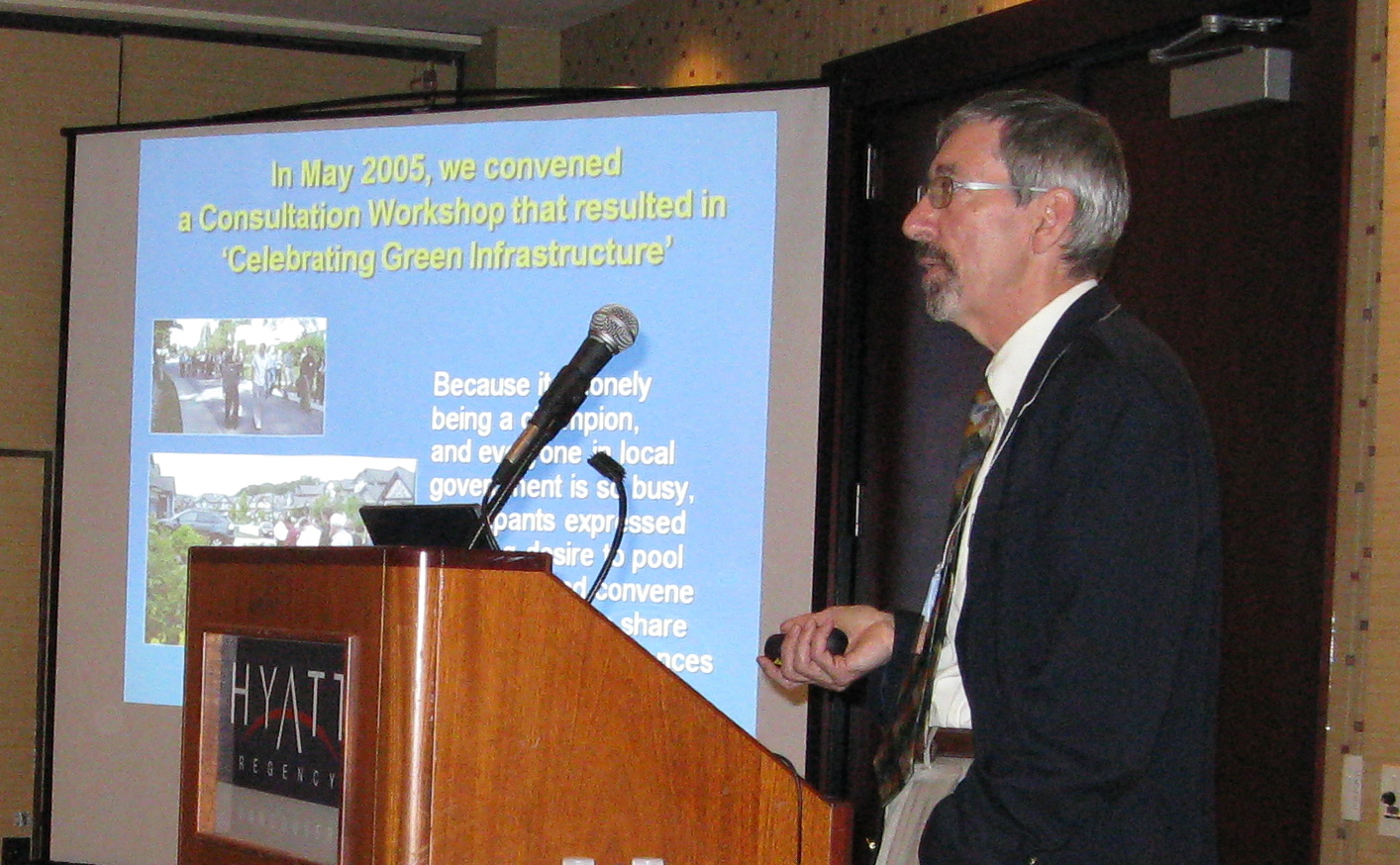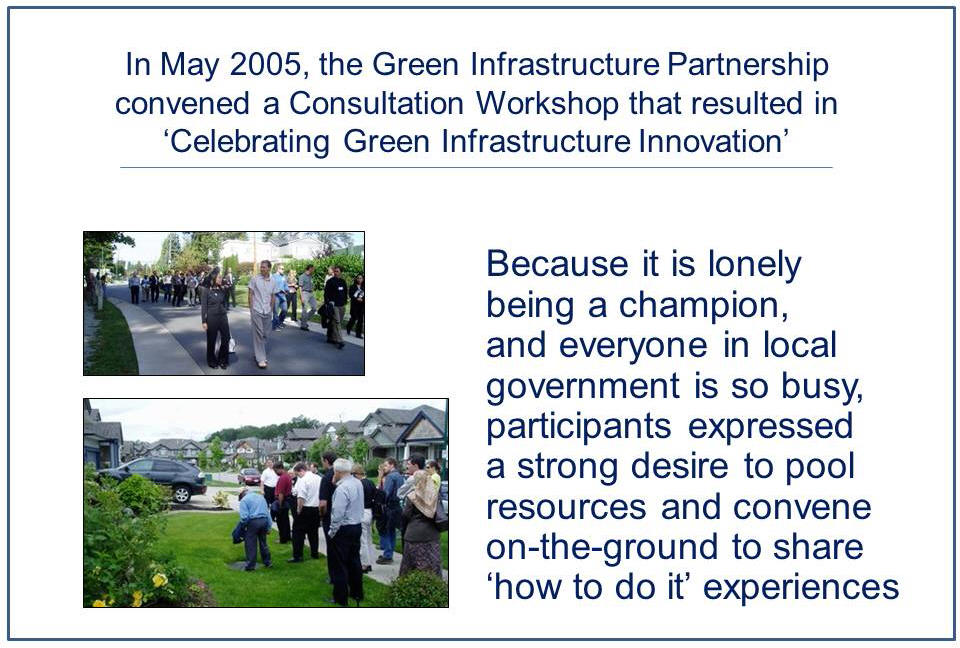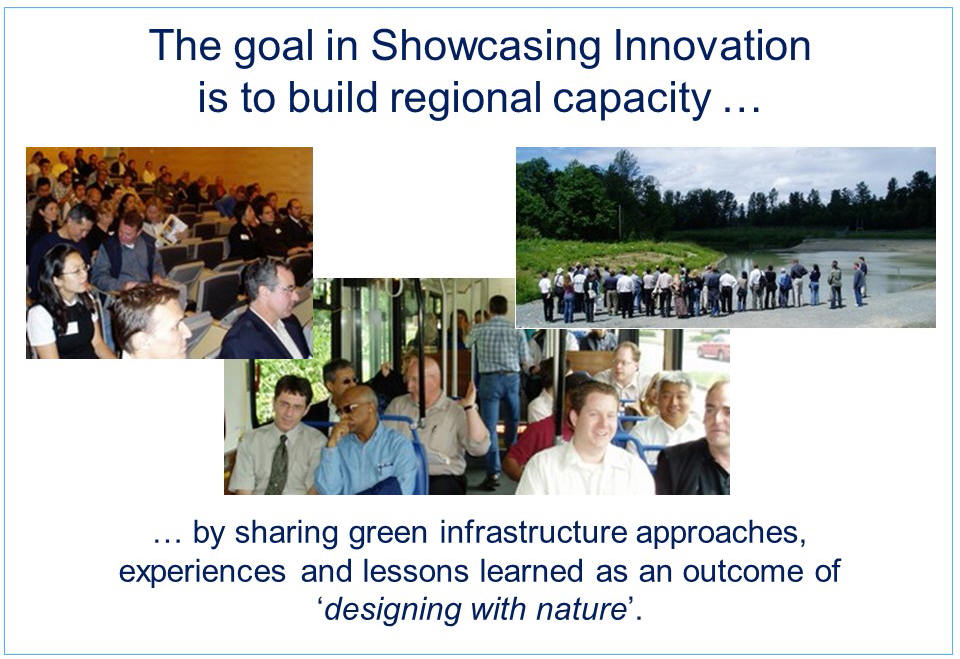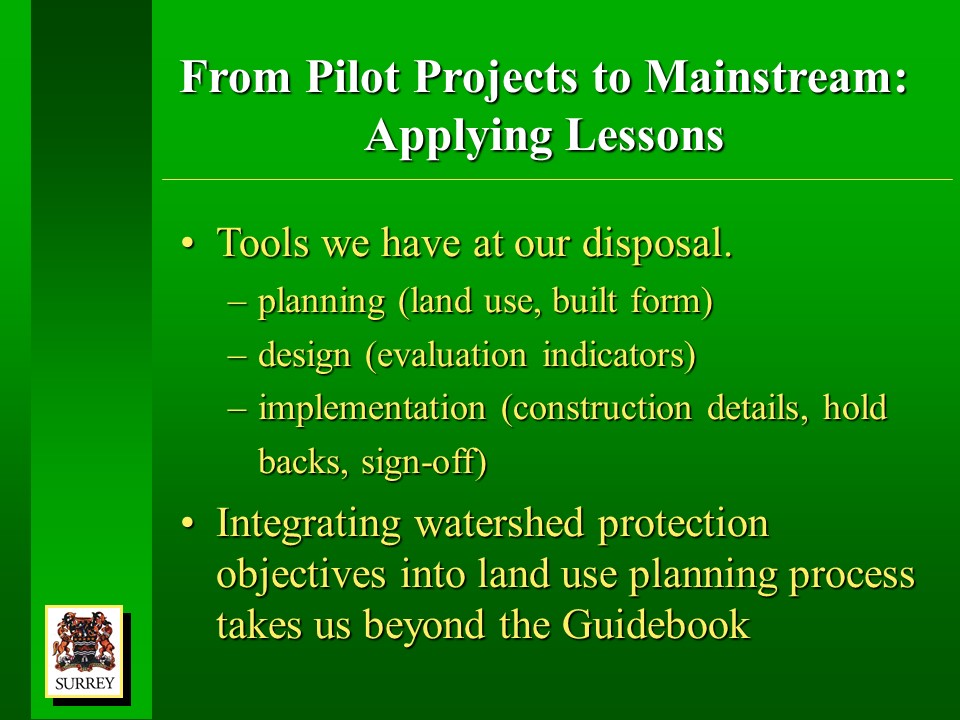CELEBRATING A DECADE OF SUCCESS: “Green infrastructure practices have moved from pilot project to neighbourhood and watershed scale approaches,” reflects Paul Ham, an early green infrastructure champion
Note to Reader:
 Paul Ham was with the City of Surrey for over 30 years, where he had a distinguished career and rose to City Engineer. In 2005, he succeeded Chuck Gale as Chair of the Green Infrastructure Partnership. He served as Chair until 2008 when he retired from the City. He continued as Past-Chair until 2010. Under his leadership, initiatives undertaken by the Green Infrastructure Partnership enhanced the credibility of the Water Sustainability Action Plan for British Columbia.
Paul Ham was with the City of Surrey for over 30 years, where he had a distinguished career and rose to City Engineer. In 2005, he succeeded Chuck Gale as Chair of the Green Infrastructure Partnership. He served as Chair until 2008 when he retired from the City. He continued as Past-Chair until 2010. Under his leadership, initiatives undertaken by the Green Infrastructure Partnership enhanced the credibility of the Water Sustainability Action Plan for British Columbia.
 “Under Paul Ham’s leadership, the Green Infrastructure Partnership has achieved a great deal since 2005,” stated Ray Fung when he succeeded Paul Ham as Chair in 2008. “The Showcasing Green Infrastructure Innovation Series, for example, has helped local government practitioners immeasurably by creating forums for them to share their experiences and lessons learned. This has created a ripple effect that has spurred even more innovation.”
“Under Paul Ham’s leadership, the Green Infrastructure Partnership has achieved a great deal since 2005,” stated Ray Fung when he succeeded Paul Ham as Chair in 2008. “The Showcasing Green Infrastructure Innovation Series, for example, has helped local government practitioners immeasurably by creating forums for them to share their experiences and lessons learned. This has created a ripple effect that has spurred even more innovation.”
 “The paradigm-shift that occurred during Paul Ham’s watch far exceeds our original expectation that the partnership would be a catalyst for change,” added Chuck Gale, Founding Chair of the Green Infrastructure Partnership, in a 2008 statement. ”I am so proud of all those committed participants who have been instrumental in making this initiative an unqualified success in BC’s environmental history.”
“The paradigm-shift that occurred during Paul Ham’s watch far exceeds our original expectation that the partnership would be a catalyst for change,” added Chuck Gale, Founding Chair of the Green Infrastructure Partnership, in a 2008 statement. ”I am so proud of all those committed participants who have been instrumental in making this initiative an unqualified success in BC’s environmental history.”

At the rollout of “Beyond the Guidebook” in November 2007, Paul Ham explained the strategic importance of the Showcasing Green Infrastructure Innovation Series as a catalyst for implementing changes in practice that reflect a ‘design with nature’ philosophy.
Reflections on Chairing the Green Infrastructure Partnership
“I can still remember the day that the City of Surrey’s Planning General Manager, Murray Dinwoodie, came into my office in 2005. He said that Chuck Gale was looking for a new person to chair the Green Infrastructure Partnership (GIP) and would I be prepared to step in. It was just what I did not need at the time, an extra job to do,” recalls Paul Ham.
and would I be prepared to step in. It was just what I did not need at the time, an extra job to do,” recalls Paul Ham.
“Chuck had just retired as the City Engineer for Richmond, was stepping down as GIP Chair, and a new volunteer was needed to take Chuck’s place. However, realizing that this was an important Partnership to be involved with in this time of rapidly changing servicing standards and ways of better managing rainwater, I, somewhat tentatively, agreed to help out.”
 “This was about the same time that the City of Surrey was looking at trying out new, more sustainable, servicing standards for the new neighbourhood of East Clayton which was about to develop. These new development standards were being developed in conjunction with the UBC School of Landscape Architecture, led by Patrick Condon.”
“This was about the same time that the City of Surrey was looking at trying out new, more sustainable, servicing standards for the new neighbourhood of East Clayton which was about to develop. These new development standards were being developed in conjunction with the UBC School of Landscape Architecture, led by Patrick Condon.”
“Shortly after becoming GIP Chair, I met with my peers on the Metro Vancouver Regional Engineers Advisory Committee (REAC), and asked them to support and participate in a Green Infrastructure Consultation Workshop that the City of Surrey would host in May 2005 on behalf of the GIP. This proved to be a transformational event. The majority of Metro Vancouver municipalities participated. The ‘Convening for Action’ initiative was well and truly launched.”
To Learn More, Click On:
British Columbia’s Green Infrastructure Partnership
2004 & 2005 Green Infrastructure Consultation Workshops
Request to REAC to participate in Green Infrastructure Consultation Workshop – 2005
Leading Change in the Metro Vancouver Region
“For quite some time Surrey had been working to move beyond the ‘collect it, pipe it and forget it’ school of drainage practice and had brought in requirements to control peak flows, on a development by development basis, in the late 1970s,” continues Paul Ham.
“However, it came to be realized that this was only a partial solution and that more holistic and watershed-neighbourhood scale approaches combined with and innovative servicing standards were required.”
“Innovative servicing standards provide more on-site rainwater capture, more infiltration into the ground and the slow of the run off response to rainfall events. However, many of these innovative servicing standards had not been tested over the longer term for their continuing effectiveness, public acceptance, and maintenance costs.”
“Consequently there was a reluctance by municipalities for major changes in their servicing standards without them having a proven track record. This institutional inertia to change can only be overcome with the help of better understanding and demonstrated success of new approaches.”
“East Clayton was an early application of innovative servicing standards on a neighbourhood scale, with the intention of achieving a flow regime that would protect downstream watercourses and low elevation farmlands which were subject to flooding.”
To Learn More, Click On:
Green Infrastructure in the City of Surrey: Building on a Decade of Experience
Showcasing Green Infrastructure Innovation Series
“Chairing the Partnership made me realize how many new ideas in sustainable servicing were being tried out around the Region and the Province,” emphasizes Paul Ham. “To spread the word on what was happening in the region a number of one day seminar and field demonstration events were held under the banner of the Showcasing Green Infrastructure Innovation Series.”
“Launched in May 2006, the program was organized as a workshop in the morning followed by field tour in the afternoon. This format created opportunities for practitioners to network and share “how to do it” experiences on the ground. The host municipalities set the scene for the field tour by providing comprehensive and in-depth presentations.”
“This series of seminars-demonstration was well attended and highlighted innovations in Surrey, UniverCity in Burnaby, UBC, Delta, Vancouver and more. It demonstrated the wide interest in new ways of rainwater management and helped share knowledge and practical experience on their degree of success. These sessions in the Lower Mainland were followed by similar ones on Vancouver Island.”
To Learn More, Click On:
Showcasing of Green Infrastructure Innovation in British Columbia
Beyond the Guidebook: Expectations for Rainwater Management & Green Infrastructure
“The GIP also worked with the Master Municipal Construction Documents (MMCD) group in their development of an updated design manual that included optional criteria for innovative rainwater management,” adds Paul Ham.
“During this time the Water Balance Model was further developed, as was the Water Bucket web site to provide a forum for new ideas and developments in rainwater management. Also during this time West Coast Environmental Law which was a partner on the GIP worked on law and policy reform aimed at more sustainable development.”
“In the fall of 2007, the GIP collaborated with APEGBC to jointly organize the first Beyond the Guidebook Seminar. The response by the engineering community and others was overwhelming, and came as a welcome surprise. Attendance was capped by the room capacity and there was a waiting list. Although the majority of attendees came from Metro Vancouver and the Fraser Valley, the seminar attracted a province-wide audience.”
“Because the GIP Steering Committee included the Ministry of Community Services and Fisheries and Oceans Canada, the seminar provided a timely opportunity to inform local government and land use practitioners regarding the emerging policy framework and senior government expectations for applying a Beyond the Guidebook approach to land development and watershed management.”
To Learn More, Click On:
2007 Beyond the Guidebook Seminar
From Pilot Projects to Mainstream
“I see my years of chairing the Green Infrastructure Partnership as helping to get the ball rolling and ideas disseminated, on green infrastructure, all of which has subsequently been taken up by others to a much greater degree of implementation and success,” reports Paul Ham.
“Green infrastructure practices have moved from pilot project to neighbourhood and watershed scale approaches. There were many people who were involved in the work of the committee but I have to particularly thank Kim Stephens, for all his help and support through my time as the Chair of the GIP, without which much less would have been achieved.”
“So while I may have been tentative at first on Chairing the GIP, I am glad that I did and believe that in some substantive ways our efforts a decade ago advanced the cause of sustainable development and moved the state of-the-art of green infrastructure to a more mainstream level.”
To Learn More, Click On:
The Partnership for Water Sustainability in BC is the “keeper of the GIP legacy”
“The Green Infrastructure Partnership was an original element of the Water Sustainability Action Plan for BC, released in 2002. Starting with the 2005 REAC Consultation Workshop, the early success of the GIP built awareness and galvanized action on the ground.”
“This success helped to lay a strong foundation for incorporation of the Partnership for Water Sustainability in BC as a not-for-profit society in 2010. This entity is now the hub for a ‘convening for action’ network in the local government setting, and the keeper of the GIP legacy,” concludes Paul Ham.
To Learn More, Click On:
Partnership for Water Sustainability History Paul Ham honoured as a Lifetime Member of the Partnership for Water Sustainability 







